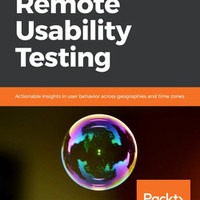A review of
 Remote Usability Testing
Remote Usability Testing
by Inge De Bleecker and Rebecca Okoroji
Publisher: Packt Publishing
174 pages, 9 chapters
About this book
A good reference for Methods/How-To
Primary audience: Researchers and designers who have are new, have some experience, or significant experience with the topic
Writing style: Matter of fact
Text density: Mostly text
Learn more about our book review guidelines
Bleecker and Okoroji ask, “Does the world really need yet another book about usability testing? We believe it does as there are no books available that are focused solely on the very exciting realm of remote usability testing.”
As someone who has planned and conducted numerous usability tests and managed a traditional in-person usability test lab, I can say that I agree with the authors!
Experienced UX practitioners, those new to usability testing, designers, stakeholders, project managers, product development managers, and anyone else invested in the findings will learn some of the following from this book:
- How remote tests differ from traditional lab tests
- How to recruit participants
- How to plan and conduct tests including dry runs
- How to use video
- How to analyze and report
The main sections of the book are clearly outlined in the table of contents. For example, the table of contents lists the section “How to Effectively Recruit Participants” not just by section title, but it lists how to find, recruit, screen, and inform participants. Readers do not have to spend time sifting through the book to get helpful information.
The authors provide screenshots and diagrams to illustrate how to plan and conduct the tests as well as how to analyze and report the data. I appreciate that they provide a link in the book’s preface to a PDF file that has color images of the screenshots and diagrams used in the book. This is an uncommon feature for how-to guides to provide.
There are several examples of how to report findings with graphs and diagrams, including bar and column graphs, cluster diagrams, and pie charts. These examples help the reader know how to quickly show the data to those invested in the results.
One section in particular illustrates a major difference between traditional lab and remote testing. This section also describes the use of video to monitor, watch, and capture participant data regardless of whether the test is moderated or unmoderated with a test facilitator.
In traditional usability testing, a video feed allows researchers to watch testing in a viewer room. Remote tests can allow viewers to access their mobile device to watch the tests as they occur. The use of video capture in remote tests, however, can result in some issues. I appreciate that the authors mention limitations of video including privacy concerns, the likelihood of less think-aloud customer responses, and issues with Digital Rights Management (DRM), an approach to prevent unauthorized distribution of digital media such as a recorded movie.
Another section describes considerations for running unmoderated studies with a survey. Anyone who has taken an online survey knows there can be issues with wording and the order of the questions asked. The authors have addressed these and other issues with examples of rating scales and survey questions, such as “What functionality would you like to see added?”
There is a lot of information in the book devoted to how to construct tasks, task questions, the order of those questions, how to avoid leading questions, and how and why to perform a pilot test or dry run to address any problems. There is also information on how to resolve any technical glitches that arise. For instance, participants can perform tests on their own devices which might have browser, screen size, and download issues. The book helps resolve these issues.
The authors have written the definitive book on a method of user research for experienced and new practitioners to learn about users’ motivations, preferences, and behaviors to inform design decisions that ultimately drive business strategy and product development. In today’s fast-paced and competitive business environment, remote testing effectively reaches more customers simultaneously and captures data in real-time.
I highly recommend you purchase a copy of this book for your professional library.
Karen Shor has worked as a Usability Specialist and Human Factors Engineer, managing the usability labs, conducting many usability tests, and working with product development teams and stakeholders to implement test findings to improve the user experience and help drive business strategy.

